Your ZZ plant will flourish with the right light and a well-draining potting mix. One of the biggest misconceptions about ZZ plants is that they thrive in dark corners, while they can tolerate low light, they’ll do much better with bright, indirect light.
I’ve successfully grown many ZZ plants over the years, and today I want to share how to care for them and the conditions that will help them thrive.

ZZ Plant Light Requirements
The ZZ plant is often called a low-light plant, but it still needs decent light to stay healthy. Those thick nodes at the base store water and nutrients, which helps the plant survive in poor conditions temporarily. Over time, if conditions don’t improve it will start to decline and eventually die.
How Much Light Does a ZZ Plant Need?
A few hours of bright, indirect light each day is ideal. Somewhere near a sunny window works well. And unlike a lot of houseplants, the ZZ can actually take a bit of direct sun. That alone should tell you it’s not really a “low light” plant. It can survive the shade, but it doesn’t love it.
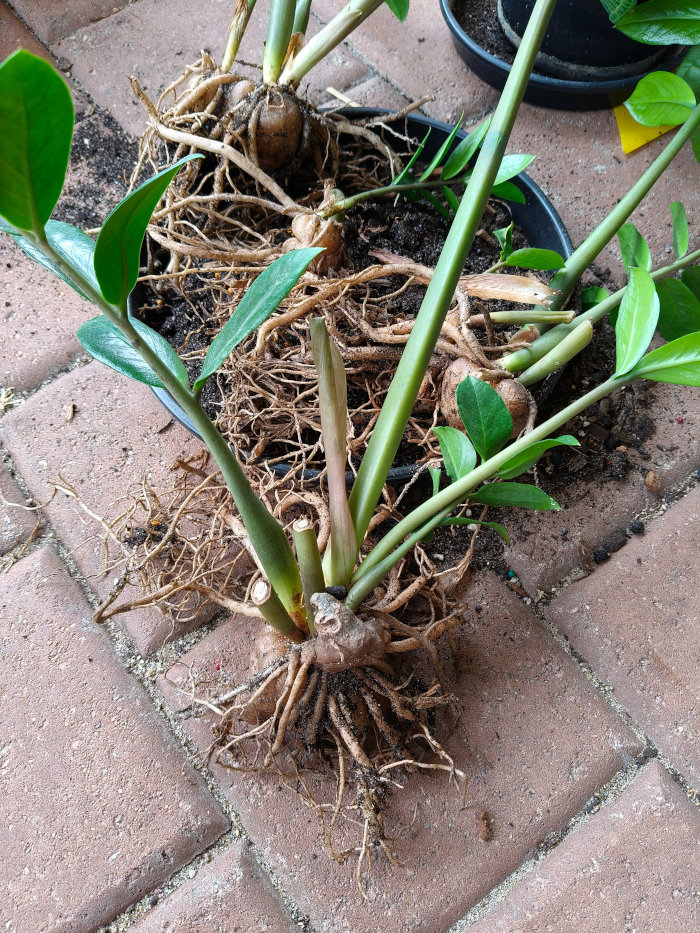
Can ZZ Plant Grow in Low Light?
Technically, yes—they can survive in low light. But you won’t get any real growth out of them. If you’re putting one in a shady corner, go for a mature plant. That way, you’re not expecting much in terms of new leaves. It’ll stay alive, just not happy. A small plant in that kind of light won’t do much at all, and eventually, it’ll just fizzle out.
How to Tell If the Light Is Good Enough
ZZs are slow growers but if there is very little growth, leggy-stems or weak, floppy leaves, these indicate too little light. A healthy ZZ plant grows tight and compact, with upright stems. That’s what you’re aiming for. If it starts looking stretched or sparse, it’s time to reassess the lighting situation.
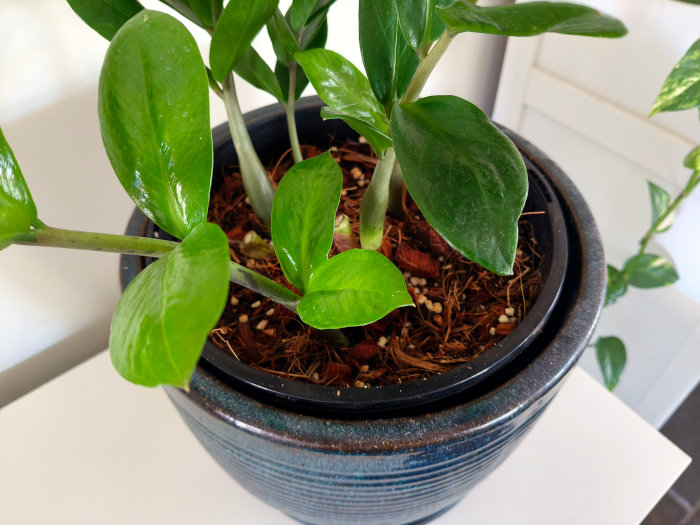
ZZ Plant Water Requirements
ZZ plants are built for drought. Those thick, nutrient-storing nodes at the base help the plant survive long dry spells without much trouble. This is what makes them so popular as low-maintenance plants, missing a watering isn’t a disaster.
How Often to Water a ZZ Plant
I water mine every two weeks, and that works well with the chunky mix I use. If your soil is heavier or holds moisture longer, you might be able to go three to four weeks between waterings. There’s no exact schedule—just check the soil. If it’s still damp a couple of inches down, wait a little longer. A drier mix might need more regular checks.
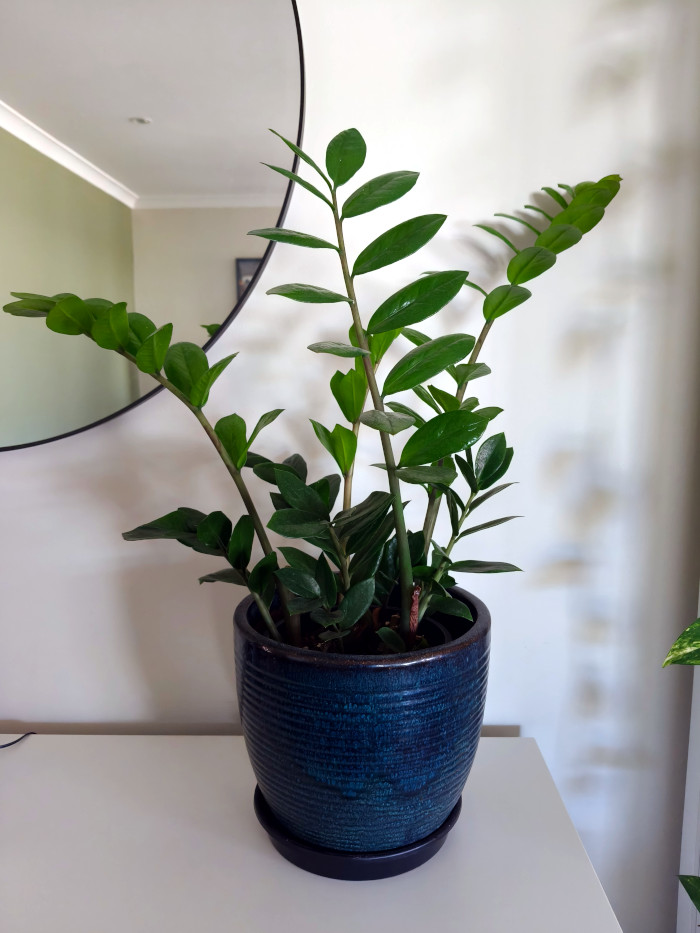
When to Water a ZZ Plant
This one’s not always easy to time. ZZ plants don’t show thirst clearly, so you have to rely on the soil. Let it dry out completely, then give it a few more days for good measure. If you notice soft stems or wrinkling leaves, that’s a sign it’s overdue for water. But in general, they’d rather go dry than sit wet.
How to Water a ZZ Plant
Top watering or bottom watering—both are fine options for ZZ plants. I usually top water mine since I use a chunky mix that drains quickly, and it works well. If you’re using a denser, more moisture-retentive mix, bottom watering might be a better choice. It helps avoid overwatering while still giving the roots a good soak.
ZZ Plant Soil Requirements
The ZZ plant soil mix I use for my ZZ plant is chunky and free-draining. These plants don’t like sitting in moisture—too much water around the roots can lead to rot. Since ZZs store water in their thick rhizomes, they don’t need soil that holds on to moisture for long. A well-aerated mix helps keep the roots healthy and prevents overwatering issues.

Temperature
Warmer temperatures are best for ZZ plants. They’ll tolerate cooler conditions, but growth tends to slow down. Warmth encourages more consistent growth, so if you’re trying to keep your plant active year-round, a steady warm environment helps.
Humidity
I haven’t noticed humidity making much of a difference with ZZ plants. They seem perfectly fine in average indoor conditions, so there’s no need to fuss over it. Just focus on light, water, and soil—humidity really doesn’t matter much here.
ZZ Plant Care and Maintenance
Fertilizing ZZ Plants
You can use either a liquid fertilizer or slow-release granules—both work fine. Granules are the easier option. Just sprinkle them on top of the soil and water as usual; a bit will release each time. If you prefer liquid fertilizer, every other week during the growing season works well. Just remember to ease off during the colder months when the plant isn’t actively growing.
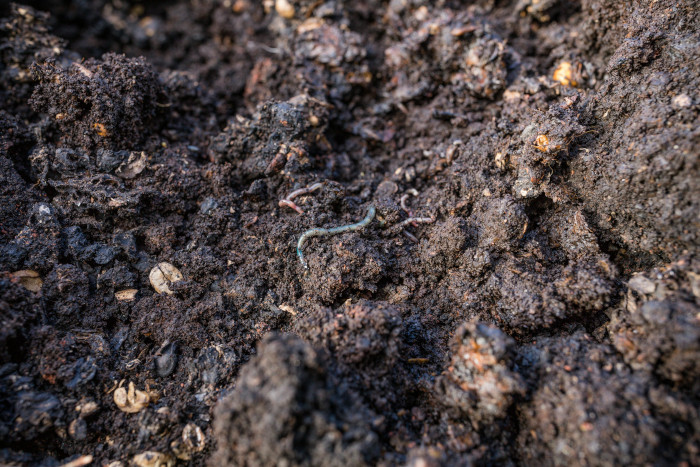
Common Pests
I haven’t had any issues with pests on ZZ plants—they’re generally pretty tough. But like any houseplant, they’re not completely immune. Common pests you might come across include:
- Spider mites
- Mealybugs
- Scale
- Fungus gnats (if the soil stays too wet)
Keep an eye on the undersides of the leaves and the base of the plant. Catching problems early is the easiest way to deal with them.
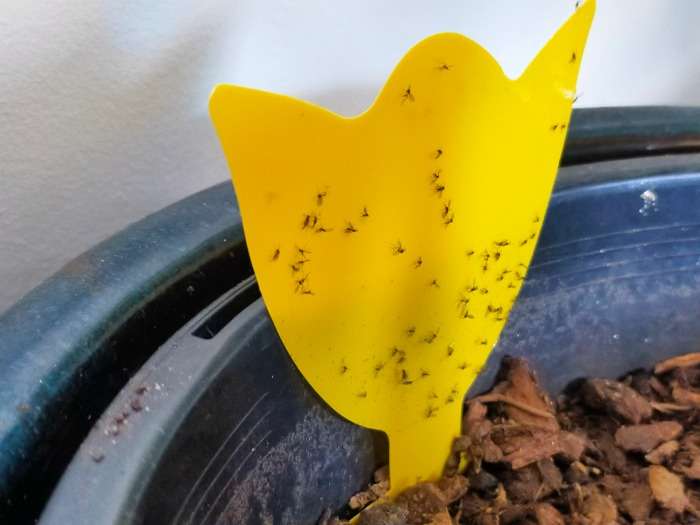
Repotting Your ZZ Plant
You only need to repot your ZZ plant every few years. It’s slow-growing and tough, so it doesn’t demand frequent repotting like some other houseplants.
When you do repot, make sure to do it properly to avoid damaging the roots and to give your plant the best chance of settling into its new home. Use a well-draining mix, handle the root ball gently, and choose a pot that’s just one size up—too much space can lead to overwatering issues.
Conclusion
ZZ plants are tough, but they won’t thrive if you keep them tucked away in a dark corner. In my experience, bright light and a free-draining soil mix are the two main keys to keeping them healthy long-term.
Watering is simple once you get a feel for your conditions, and they don’t need much else—just the occasional feed and a bit of patience. With the right setup, they pretty much take care of themselves.

